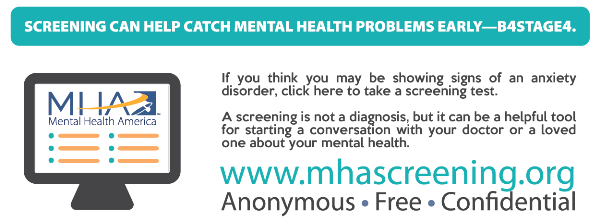You are here
Anxiety Disorders
- Generalized Anxiety Disorder (GAD)
- Obsessive-compulsive Disorder (OCD)
- Panic Disorder
- Phobias
- Post-Traumatic Stress Disorder (PTSD)
- Social Anxiety Disorder
- Infographic: Life with Anxiety
- Infographic: How To Deal With Stress and Anxiety
Anxiety Disorders: What You Need to Know
Most people experience feelings of anxiety before an important event such as a big exam, business presentation or first date. Anxiety disorders, however, are illnesses that cause people to feel frightened, distressed and uneasy for no apparent reason. Left untreated, these disorders can dramatically reduce productivity and significantly diminish an individual's quality of life.
How Common Are Anxiety Disorders?
Anxiety disorders are among the most common mental illnesses in America; over 21% of adults (42.5 million) are affected by these debilitating illnesses each year. [1]
What Are the Different Kinds of Anxiety Disorders?
Generalized Anxiety Disorder; Chronic, exaggerated worry about everyday routine life events and activities, lasting at least six months; almost always anticipating the worst even though there is little reason to expect it. Accompanied by physical symptoms, such as fatigue, trembling, muscle tension, headache, or nausea.
Obsessive-Compulsive Disorder; Repeated, intrusive and unwanted thoughts or rituals that seem impossible to control.
Panic Disorder; Characterized by panic attacks, sudden feelings of terror that strike repeatedly and without warning. Physical symptoms include chest pain, heart palpitations, shortness of breath, dizziness, abdominal discomfort, feelings of unreality, and fear of dying.
Phobia; Extreme, disabling and irrational fear of something that really poses little or no actual danger; the fear leads to avoidance of objects or situations and can cause people to limit their lives.
Post-Traumatic Stress Disorder; Persistent symptoms that occur after experiencing a traumatic event such as war, rape, child abuse, natural disasters, or being taken hostage. Nightmares, flashbacks, numbing of emotions, depression, and feeling angry, irritable, distracted and being easily startled are common.
Social Anxiety Disorder;Fear of social situations in which the person is exposed to unfamiliar people or to possible scrutiny by others. The individual fears that he or she will act in a way (or show anxiety symptoms) that will be embarrassing and humiliating, often times leading to avoidance of social situations and severe distress when participation in social situations can't be avoided. [2]
What Are the Treatments for Anxiety Disorders?
Treatments are extremely effective and often combine medication or specific types of psychotherapy.
More medications are available than ever before to effectively treat anxiety disorders. These include antidepressants (SSRIs, SNRIs, Tricyclic Antidepressants, MAOIs), tranquilizers (benzodiazepines, etc.) and in some cases, anticonvulsants. A person may have to try more than one medication before finding a drug or combination of drugs that works for them. Learn more about medications.
One of the most effective forms of psychotherapy used to treat anxiety disorders is cognitive-behavioral therapy. Cognitive-behavioral therapy teaches people to understand their thinking patterns so they can react differently to the situations that cause them anxiety. Learn more about therapy.
Anxiety Disorders and Other Health Conditions
It is common for a person with one anxiety disorder to also have another anxiety disorder. Anxiety disorders are also frequently accompanied by depression or substance abuse. Anxiety disorders can coexist with physical health conditions as well. In such instances, these physical health conditions will also need to be treated. Before undergoing any treatment, it is important to have a thorough medical exam to rule out other possible causes.
From our Partners:
Read stories from people living with Anxiety Disorders on The Mighty.
Get additional information about Anxiety Disorders at Psych Central.
Other Resources
National Suicide Prevention Lifeline
800-273-TALK (8255)
www.suicidepreventionlifeline.org/
Anxiety and Depression Association of America
240-485-1001
www.adaa.org
Freedom From Fear
718-351-1717
www.freedomfromfear.org/
National Institute of Mental Health
866-615-6464
www.nimh.nih.gov
National Association of Social Workers
www.helpstartshere.org/find-a-social-worker
Sources
1. Kessler, R. C., Petukhova, M., Sampson, N. A., Zaslavsky, A. M., & Wittchen, H.-U. (2012). Twelve-month and lifetime prevalence and lifetime morbid risk of anxiety and mood disorders in the United States. International Journal of Methods in Psychiatric Research, 21(3), 169–184. http://doi.org/10.1002/mpr.1359
2. American Psychiatric Association. (2013). Diagnostic and statistical manual of mental disorders (5th ed.).









this page